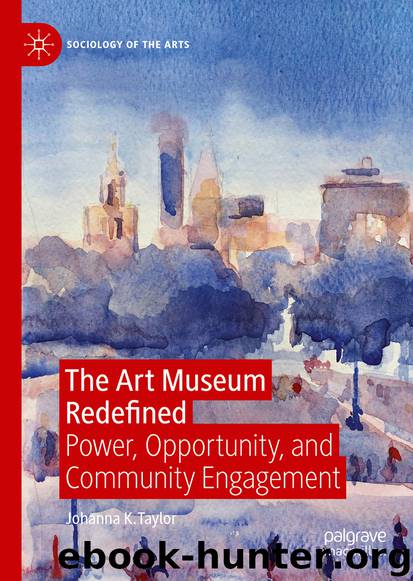The Art Museum Redefined by Johanna K. Taylor

Author:Johanna K. Taylor
Language: eng
Format: epub
ISBN: 9783030210212
Publisher: Springer International Publishing
Conclusion: Cooperation Is Curation
In making community organizing and cooperative practices a central component to museum work, the Queens Museum expresses its values, priorities, and ethics. This is a political stance. Museums are not passive institutions able to seamlessly convey an unbiased neutral body of information through their exhibitions; all work is influenced by the perspectives of curators, funders, board members, and administrators who frame the experience for visitors. The same is true in a cooperative museum practice, which is inherently political from the onset. It is a divergent choice to give the community a voice in strategic planning and curatorial practices that are typically reserved for an elite, trained few. It is a decision to disrupt typical power hierarchies in museum leadership to cede space to community members and other stakeholders to influence decisions. At IMI this means the Community Council plans all programs and manages the space, thus creating the daily enactment of aesthetics, form, and co-creation in this artwork. The Queens Museum provides support but does not hold the majority of the power in deciding what happens in the space. MPP members speak to the public, thereby garnering new insights which shape their further designs but also provide insights into the community’s concerns.
The Queens Museum implements local social change through its programs, exhibitions, and relationships with the community. By incorporating views of local residents, it becomes a “participatory cultural institution” rooted in co-creation that connects community and museum staff to support local and institutional needs (Simon, 2010). Yet the museum gives power to participants and community members who bring a diversity of cultural heritage, age, class, and perspectives to broaden programming scope and deepen local impact. This is a political practice of community engagement and active cooperation that values local impact just as much if not more than art world success.
The breadth of programs, openness and flexibility at IMI, MPP’s work across the neighborhood, and the Queens Museum’s partnership with Queens Library constitute new forms of how to expand curatorial practice and “take care” of the community through mutual support, creating safe spaces, and sharing resources and responsibilities. This work mixes art-making with curating; the daily practice is the artwork that requires continual curation to make its existence possible while connecting people. Curating is the practice of contextualizing artworks together in an exhibition, public program, or other format to create opportunities for exchange between artists and audiences. In all of the Queens Museum cooperative projects curating means to “take care” of the physical space and of the surrounding community, following a literal interpretation of the direct translation of “to curate” from the Latin curatus, the past participle of curare, meaning take care (Kuoni, 2001). In placing community members and local organizations as central to their programming practices, the Queens Museum is establishing new forms of care that value cooperation as much as aesthetic value. As Laura Raicovich suggested to me they are working to “redefine what it means [to create a] different kind of protection and care from an institution” (L.
Download
This site does not store any files on its server. We only index and link to content provided by other sites. Please contact the content providers to delete copyright contents if any and email us, we'll remove relevant links or contents immediately.
The Secret History by Donna Tartt(18849)
The Social Justice Warrior Handbook by Lisa De Pasquale(12142)
Thirteen Reasons Why by Jay Asher(8796)
This Is How You Lose Her by Junot Diaz(6794)
Weapons of Math Destruction by Cathy O'Neil(6146)
Zero to One by Peter Thiel(5686)
Beartown by Fredrik Backman(5599)
The Myth of the Strong Leader by Archie Brown(5425)
The Fire Next Time by James Baldwin(5249)
How Democracies Die by Steven Levitsky & Daniel Ziblatt(5128)
Promise Me, Dad by Joe Biden(5087)
Stone's Rules by Roger Stone(5026)
A Higher Loyalty: Truth, Lies, and Leadership by James Comey(4845)
100 Deadly Skills by Clint Emerson(4840)
Rise and Kill First by Ronen Bergman(4704)
Secrecy World by Jake Bernstein(4646)
The David Icke Guide to the Global Conspiracy (and how to end it) by David Icke(4625)
The Farm by Tom Rob Smith(4437)
The Doomsday Machine by Daniel Ellsberg(4416)
